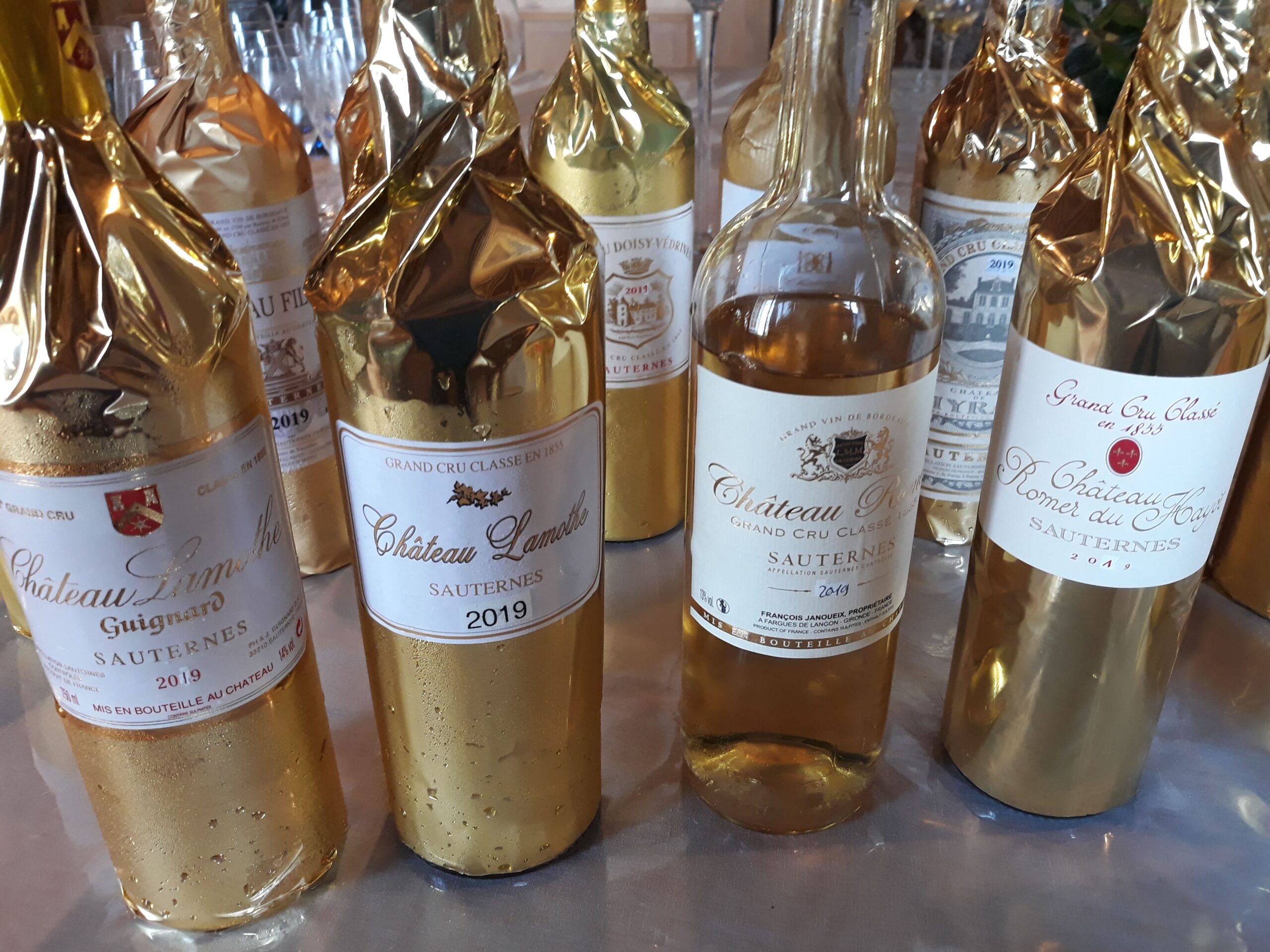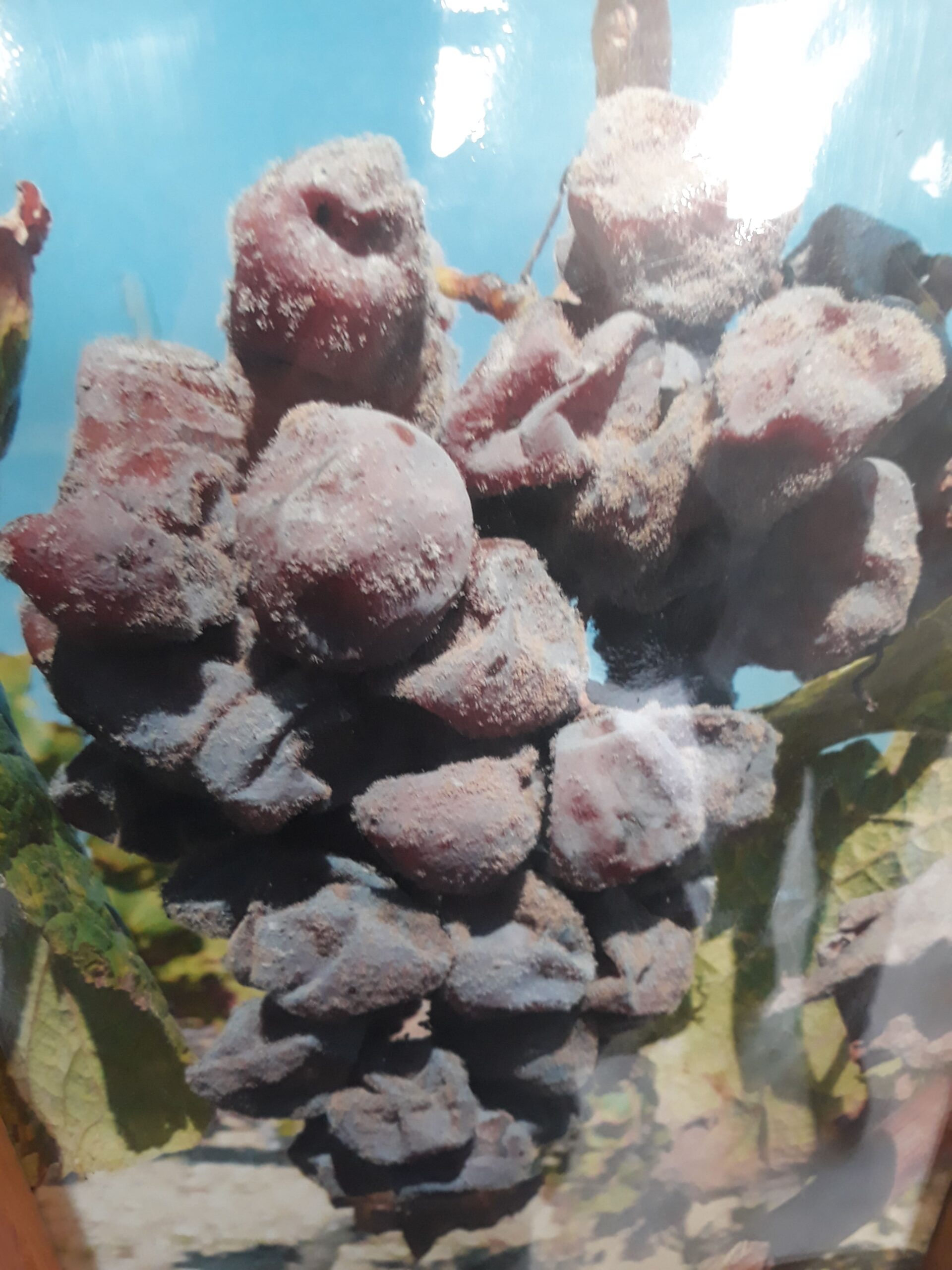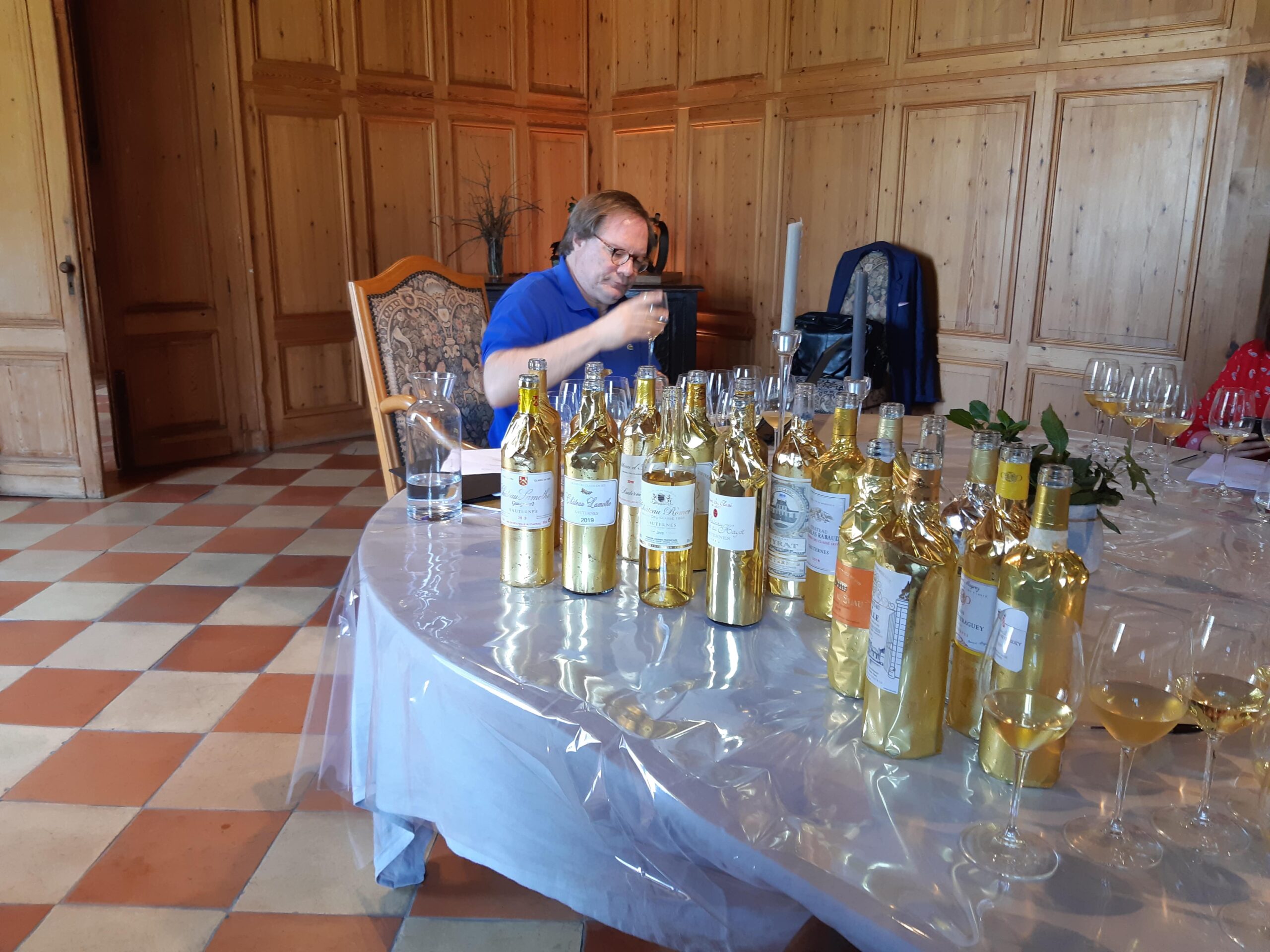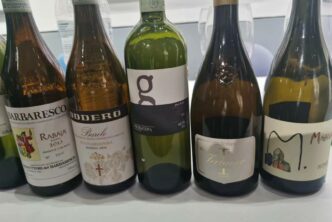我可以肯定地说,我是世界上最喜欢苏玳和巴尔萨克葡萄酒的人之一。我的酒窖里装满了来自这些产区的葡萄酒,与今天的大多数人不同的是,我经常会在整个午餐或晚餐中饮用苏玳和巴尔萨克的葡萄酒,这些美味的甜酒能够很好地跟食物搭配(除了奶酪和甜点,其实还有更多的搭配选择)。事实上,几乎没有什么时候苏玳或巴尔萨克的葡萄酒是不能被享用的。因此,我既爱这些葡萄酒年轻时候的样子,也爱它们陈年后的样子;不管是偏清淡口感的年份,还是偏丰富口感的年份;以及那些带有明显或者不明显贵腐特征的(Botrytis cinerea)酒我都爱。简而言之,我或多或少地认为,从没有一种苏玳和巴尔萨克的葡萄酒不太好。

总的来说,2019年份应该会让所有像我这样喜欢苏玳和巴尔萨克葡萄酒的爱好者们感到高兴。2019年份,这两个产区的葡萄酒主要面临的挑战是,在收获季节能够谨慎地选择葡萄,便可以酿出优质好酒,因为这一年灰霉菌和果蝇的不断困扰让人非常头痛。所以,谨慎的挑选是非常必要的,但这意味着苏玳和巴尔萨克的产量甚至比平常还要少(苏玳列级酒庄的平均产量只有区区1000公升/公顷,你不得不怀疑这些酒庄是如何经营下去的)。
简单地介绍一下产区和它们的风土
苏玳是波尔多最著名的甜葡萄酒产区,创建于1936年,位于加隆河左岸。它分布在五个村庄:苏玳村本身、巴尔萨克、博姆斯Bommes、法格 Fargues 和普里伊格纳克Preignac。在这些村庄中,只有巴尔萨克拥有自己的产区名称特权,因此巴尔萨克的葡萄酒生产商可以选择将他们的葡萄酒命名为巴尔萨克,而不是苏玳。然而,大多数人还是选择使用苏玳的名号,因为它是最著名的村庄,一个与甜葡萄酒生产紧密联系在一起的、全世界都家喻户晓的名字。
所有归属苏玳产区(以及巴萨克)的官方生产标准是相同的。允许用来酿制的葡萄只有长相思、灰苏维翁、赛美蓉和密斯卡岱;然而,这些葡萄酒绝大多数都是由赛美蓉(很多是100% 赛美蓉)和少量的长相思组成的。只有当每升葡萄必须重达221克时,才可以用手采摘。这里的葡萄酒总是奢华而丰富的,尽管在凉爽、多雨的年份,它们可能会表现出非常优雅的风格,一点也不丰饶。在炎热干燥的年份,葡萄酒会带有明显的晒干葡萄passérillage(直接在葡萄树上晾干的葡萄)的味道,非常浓郁而且甜美;在贵腐盛行的年份,葡萄酒的总体酸度更好,香气和风味更复杂,甜味更少。

苏玳产区的风土条件非常复杂,这五个村庄产的葡萄酒还是有显著差异的:虽然大多数人不能分辨普里伊格纳克Preignac和博姆斯Bommes这两个村产的葡萄酒的区别,但事实上,它们是不同的,因为这两个村的风土有明确的差异。也许最容易区分的是苏玳和巴尔萨克这两个村的葡萄酒。从地质层面来看,巴尔萨克的土壤含有丰富的石灰石和沙土,虽然在苏玳产区这两种土壤也都有出现,至少会占有一部分,石灰石可以提供更好的新鲜度,而沙土则会提供相对轻盈的质地,所以这里无疑是出产整个产区最精致的葡萄酒。相比之下,来自苏玳村的葡萄酒则出产风格最为丰富的甜酒:主要原因是这里有更高的海拔,而且多为山坡地形,使得这里有更好的空气流通,贵腐菌的出现也更加频繁,葡萄的集中度也更好。总的来说,这款酒散发着菠萝、芒果、杏干、新鲜柑橘类水果、生姜、蜂蜡和杏仁糖的香味,并带有浓郁藏红花的风味,绝对不容错过。
简单地来了解一下波尔多的年份天气
在世界上所有主要的葡萄种植区,都很容易找到一个关于葡萄生长季节的天气描述,波尔多也不例外。然而,与世界上大多数葡萄酒产区如纳帕、巴罗萨或巴罗洛不同的是,波尔多不仅与红葡萄酒联系在一起,也与非常重要的干白和甜葡萄酒(事实上,是一些世界上最好的干白和甜葡萄酒)生产联系在一起。但要酿造真正一流的甜葡萄酒,需要那些酿造理想的干白葡萄酒和红葡萄酒完全不同的天气条件。因此,在玛歌(Margaux)或波亚克(Pauillac)被视为好天气的地方,对苏玳和巴尔萨克可能就不那么理想了(苏玳和巴尔萨克是波尔多最著名、最重要的甜葡萄酒产区,但绝不是唯一的两个)。正如刚才所说,在梅多克可以被视为灾难性的天气,却是能够确保酿造令人难忘的甜葡萄酒的气候条件。由此可见,尽管苏玳和巴尔萨克都是波尔多葡萄酒,但对波尔多整个产区年份天气的概括描述,对于确定苏玳和巴尔萨克葡萄酒的质量和潜力(或波尔多的任何葡萄酒)几乎没有帮助。
天气模式对于了解任何年份和世界上任何葡萄酒产区的葡萄酒来说都是至关重要的,尤其是波尔多,因为不同波尔多产区的风土条件各不相同。比如,苏玳和巴尔萨克(大多情况)是由赛美蓉和长相思酿造的,而不是赤霞珠和梅洛:所有这些葡萄品种的生长季节、气候和土壤都有很大的不同。此外,生产苏玳和巴尔萨克葡萄酒的一个重要方面是,任何年份贵腐菌的出现与否(Botrytis cinerea),这对于左岸或右岸酿造干红葡萄酒的酒庄来说是毫无裨益的。因此,了解天气条件如何影响葡萄的成熟度(尤其是糖分和酸度),以及贵腐菌的形成是非常重要的,这对评价苏玳和巴尔萨克的葡萄酒非常有帮助。因此,在我每年关于波尔多新年份葡萄酒的报道中,我都会详细描述苏玳和巴尔萨克这一年的天气情况。

苏玳和巴尔萨克2019年份葡萄生长季的气候
在天气方面,2019年生长季的上半部分与波尔多其他地区基本相同,都是比较温和的气候;虽然有一点霜冻和浆果碎裂,但这些并不是什么大问题。然而,一个阳光明媚的7月,整个月约比前二十年年均阳光照射时间最高记录还多出了70多个小时,苏玳和巴尔萨克看比波尔多其他产区也拥有更多的降雨(大约100毫米的降雨量,而梅多克北部产区是40毫米),在加上温暖的气候,酸的冲击引发腐烂(这时并不是好的贵腐菌,它的出现在今年晚些时候)。幸运的是,随后出现的好天气,使得在良好的环境下可以提前采收(因此,2019年对苏玳和巴尔萨克来说,水源压力不像波尔多其他地区那样是个大问题;然而,一些酒庄确实出现了浆果脱水或葡萄直接在葡萄藤上枯萎的现象,所以一些缺水的情况无疑是存在的)。由于8月特别干燥和温暖,贵腐菌的出现比较晚,从9月中旬开始,虽然这期间大多数酒庄没有多去葡萄园进行筛选以及检验感染贵腐菌的葡萄,但他们从10月上半月开始进行了仔细地采收。
大多数酒庄从8月底开始采摘长相思,大约两周后开始采收赛美蓉,远远早于9月底更多的降雨袭击该地区之前进行了采收。由于这个原因,当葡萄进入酒窖时,它所含的糖分并不像后来收获的葡萄那样多,而且还带有新鲜的酸度。大多数酒庄在10月中旬就采收完毕了,这是一件好事,因为在这个月的最后十天又开始下雨。

总结
我非常喜欢2019年份的苏玳和巴萨克斯的葡萄酒。他们拥有恰到好处的丰富性,让它们非常撩人,又有足够和谐的酸度,让它们显得优雅而轻盈。在选择合适的葡萄酒时必须谨慎,因为这一年的果蝇和酸腐是一个问题,那些没有仔细筛选的酒庄确实会酿造带有绿色草本香气、微苦的葡萄酒(比如非常出色的Chateau Nairac在2019年就没有生产葡萄酒)。我们从甜葡萄酒风格的角度来看2019年份,大多数酒庄都会把2019年份和2003年以及2009年相比,这是两个著名的出产非常甜美的、甚至完全华丽的甜葡萄酒的年份(虽然在我看来,丰饶是2003年份和2009年份甜酒唯一的共同点,后者是无比出色的葡萄酒年份)。事实上,尽管2019年足够丰富,甚至出产有点闷热的葡萄酒,但它和两个年份相比丝毫没有油腻的感觉,反而比这两个年份更加清新,它当然优于2003年的葡萄酒,但大部分复杂性稍逊2009年葡萄酒。我认为那些最优质的酒庄,它们2019年份的葡萄酒将保持优质,对于那些足够幸运可以买到它们的人来说可以提供难忘品酒体验,并且是值得窖藏的最成功年份之一(读者应该注意到,这份报告包含了2018年份的滴金酒庄,不是2019年,因为这是酒庄当时在期酒品鉴上提供的年份。我将很快会单独写一篇关于2019年滴金酒庄的文章)。
尽管新冠病毒在2020年降临到我们所有人的身上,但我在2020年夏季的几个月里多次访问了苏玳和巴尔萨克的酒庄,并在那里进行了品鉴,写下了这份报告。我要特别感谢Chateau Guirad的普兰蒂家族 Planty family,他们为我收集了大量的样品,并让我有机会直接在他们宏伟的庄园进行品鉴。

Broustet.
Not that many people know that the barrique, the 225 liter oak barrel associated with most great French wines, is believed to have been first used at Broustet, where a cooperage was first set up many centuries ago. The property sits on clay-calcareous and sandy soils that can give wines of sneaky concentration, but I don’t think this property’s full potential has yet been attained, with variation from vintage to vintage that can be marked, so taste ahead.
Chateau Broustet Sauternes 88-90
Bright deep yellow. Green tea, white flowers, tangerine jelly and hints of dried herbs and woodsy underbrush on the nose and in the mouth. Suave and juicy on entry, then a little tighter in the middle, picking up a stronger herbal note on the long, slightly bitter and astringent finish (though the herbal presence is less strong and bothersome here than in some other 2019 Sauternes, it’s still not much to my liking).
Clos Haut Peyraguey.
2019 Clos Haut Peyraguey Sauternes 92-95
Bright deep yellow. Enticing aromas of orange marmelade, almond, vanilla bean, peach and crystallized ginger. Then rich, luscious and dense, with yellow fruit jam and honey-roasted yellow fruit flavors. Always in the richer, thicker and denser style that is highly typical of the wines of Clos Haut Peyraguey, the 2019 Clos may not be the last word in refinement, but it’s hard to argue with this wine’s lusciousness and sweet sultry charm. The estate belongs to Bernard Magrez, who bought in 2012.
d’Arche.
Chateau d’Arche Sauternes 89-92
Deep luminous yellow. Rich aromas of quince, dried apricot, pineapple, honey and a hint of coffee reduction. Big, fat, and ripe on entry, then more nervous in the middle and on the long back end that features noteworthy tannic bite. Showcases very good balance overall. This pretty wine could have used a little more fruity fleshiness to stand up to its tannic backbone, but I like the sense of precision it exudes.
de Malle.
Chateau de Malle Sauternes 94-97
Vibrant yellow. Perfumed aromas and gentle flavours of lemon curd, grilled pineapple, lime jelly, saffron and dried ginger. This beautiful wine is one of the most precise and pure Sauternes of the 2019, though in typical de Malle style it is politely-styled and light on its feet. Finishes very long with iodine, smoky and medicinal twists. One of the best young de Malle’s I have memory of at a similar stage of development.
de Myrat.
Chateau de Myrat Sauternes 93-96
Deep golden-yellow. Pungent floral notes (lavender, peony), candied apricot and crystallized kumquats vie for attention on the nose and in the mouth. This actually smells and tastes as if it the grapes were partly air-dried. This knockout 92% Sémillon, 4%Muscadelle and 4%Sauvignon Blanc showcases outstanding sugar-acid balance (135 g/L residual sugar and 7 g/L total acidity) and closes very long, round, ripe and smooth. Note that this is one of the many properties that though situated in Barsac, prefers to use the better known name of Sauternes on its label.
Doisy Daëne.
Chateau Doisy Daëne Barsac 94-97
Vivid yellow with deep golden tinges. Offers explosive aromas of vanilla and lemon custard cream, complicated by white flowers and nuances of tropical fruit. On the palate, this boasts extremely pure, voluptuously intense flavours similar to the aromas and a creamy texture that makes it truly hard to put the glass back down. Fr such a rich thick wine, this is not at all over the top and has just enough acidity to keep it dancing on your taste buds rather than come across as chunky or cloying (there are roughly 156 g/l residual sugar and 7 g/l total acidity). Finishes long and clean, with a mineral tinge that is typical of Barsac.
Doisy-Védrines.
Chateau Doisy-Védrines Sauternes 92-93
Bright medium-deep golden-yellow colour. The deep nose offers pineapple, canned peach, caramel, almond syrup and spicy oak. Big, rich and voluminous, as is in the usual house style with this wine, boasting a thick, unctuous mouthfeel with decadently sweet flavours of tropical fruits, sweet spices and honey. Closes long and sweet. Though maybe not the last word in refinement, this is an outstanding sweet white wine that will have many admirers: there’s a lot of wine here for the money. is one of the many properties that though situated in Barsac, prefers to use the better known name of Sauternes on its label.
Filhot.
An extremely ancient estate founded in 1709 by Romain de Filhot, a conseiller of the Bordeau Parlament, it is now run by Gabriel de Vaucelles a direct descendant of de Filhot (meaning more than 300 years of the same family ownership, practically unheard of in today’s wine world). The Chateau and estate grounds are some of the most beautiful in all Bordeaux: 350 hectares large, Filhot boasts sixty-two hectares under vine (roughly 50% Sémillon, 48% Sauvignon Blanc and 2% Muscadelle) and a beautiful English-style garden designed by famous landscapist Louis-Bernard Fischer in 1845. The wines are always shut and closed down at first and so are a little tough to judge when young but blossom beautifully in the bottle and in my experience tend to be spectacular with ten-fifteen years of age under their belt.
Chateau Filhot Sauternes 93-96
Very bright pale yellow. An initially quite strong note of reduction blows off with aeration, to then reveal enticing aromas of fruit salad and flowers along with nuances of grilled nuts, marzipan, orchard fruit, vanilla and a strong note of ginger. Offers lovely inner-mouth perfume and bright, balanced acidity to frame the sweet fruit salad flavours. Finishes with a restrained sweetness and outstanding lift and perfume. This is a really lovely Filhot, well done.
Guiraud.
Chateau Guiraud Sauternes 93-96
Full, vibrant yellow-gold. Subtle yet very complex nose offers saffron, lemon peel, orange marmalade and caramel, complemented by a sexy marzipan undertone. Dense and luscious but with excellent focus and energy to its high-pitched orange, sweet spice and honeyed flavours, complicated by a very good, clean botrytis character. Boasts lovely freshness so does not seem nearly as sweet as it really is but did become more rich and viscous as it sat in my glass. Finishes clean, firm and long, with a saline and caramel complexity. In 2019, Guiraud had to throw away 70% of its harvest because of acid rot, and so was one of the many Sauternes estates that reported an average yield of 10 hL/ha for the year (not that at Guiraud it is much higher even in other years, as normally yields at the property hover around 15-18 hl/ha, but at these levels even a modest drop is threatening to financial well-being).
Lafaurie Peyraguey .
2019 Chateau Lafaurie Peyraguey Sauternes 93-96
Luminous pale golden-yellow. Subdued nose of yellow apple, pear and peach, complicated by honeyed nuances. Then rich, ripe and luscious in the mouth, with pure, penetrating flavours of exotic fruits toffee, canned peach and crystallized ginger. Despite its refreshing acidity, this delicious Sauternes’ texture is very creamy. Closes extremely long and precise, denoting outstanding sugar-acid balance and a delicate, refined sweetness that is not at all over the top. Sneaky concentration and complexity here.
Lamothe.
2019 Chateau Lamothe Sauternes 93-96
Vivid pale yellow gold. Intense, precise aromas of peach, nectarine, lemon peel, honey and saffron. Suave, sweet, rich and round in the mouth, yet at the same time remarkably elegant and fresh. Closes long and clean with very pure lifted flavours of fresh citrus fruits, cinnamon and almond paste. Unless memory fails me completely, this is either the best or at no worse one of the three best Lamothe wines I have ever tasted at a similar stage of development. Very well done.
Lamothe-Guignard.
2019 Chateau Lamothe-Guignard Sauternes 93-96
Bright good pale yellow. Lemon peel, pineapple nectar, and sweet spices on the nose. Lively, suave and moderately glyceral, with seamless, refreshing flavours of yellow peach, lime, coconut and vanilla. Boasts wonderful inner-mouth perfume and vibrancy leaving a lingering impression of great elegance and freshness on the long, saline close. Nicely done here. Another outstanding young 2019 wine that is one of the best samples I have ever tasted at a similar stage of development from this property.
Rayne Vigneau.
Eighty-four hectares large, Château de Rayne Vigneau is an extremely ancient Sauternes property the history of which dates back to the seventeenth century. Records show the founder, Gabriel de Vigneau, was present at the Domaine du Vigneau already back in 1635; in 1834, Madame de Rayne, born Catherine de Pontac, bought the property but it was only much later, thanks to one of her descendants, Albert de Pontac, that the estate comes to its present day name of RayneVigneau. Today Chateau de Rayne Vigneau belongs to the Trésor du Patrimoine groupe and is directed by Vinceent Labergère, with the consultant winemaking help of Henri Boyer. The sixty-two hectares are planted to 74% Sémillon, 24% Sauvignon Blanc and 2% Muscadelle on mostly sandy gravel soils resting on a clay bedrock. However, for the past ten years, Rayne Vigneau has been renewing its vineyards, and increasing its plantings of Sauvignon Blanc taking special care to plant it on those parcels that were once historically associated with it at Rayne-Vigenau; it is an effort by the current technical team to bring Rayne-Vigneau back more in tune to its origins, when the wine was known to be amongst the most elegant of all sauternes (and in fact was at one time considered the best Sauternes right after Yquem). In this light, the estate has devised a new winemaking protocol for its Sauvignon Blanc, aimed at highlighting the precision of its Sauvignon lots; according to Labergère, this technique paid off handsomely in vintages such as 2017 and 2019.
2019 Chateau de Rayne Vigneau Sauternes 93-96
Medium-deep golden-yellow. High-pitched aromas of lemon custard cream, honey, orange marmelade, and fresh apricot, with nuances of sweet caramel oak and of noble rot adding further complexity. Rich, ripe and round, this wonderfully pure and precise young Sauternes has a nectar-like quality to its flavours of yellow apple sauce, orange and spices. Finishes long and with an exhilarating chewy texture and superb aromatic persistence. This beautiful 76% Sémillon and 24% Sauvignon Blanc blend showcases really outstanding sugar-acid balance (149 g/L residual sugar and 6.3 g/L total acidity).
Rieussec.
Founded by Carmelite monks located in Langdon (and after whom Rieussec’s second wine, Les Carmes de Rieussec, is named), Rieussec’s ownership following the French revolution passed on to various well-known Bordeaux wine families, including the Marheilac (at the time also owners of Chateau La Louvière, a property famous for white and red wines located in what is today’s Pessac-Léognan appellation) and the Gasqueton (also owners of Chateau Calon-Ségur in Saint-Estèphe) families. In 1984, the estate was sold to Domaines Baron de Rothschild (of Lafite-Rothschild fame); in 1985 Charles Chevalier was appointed general director and the property lived through a boom period, making some of the greatest wines in its history (in my view, those of the mid-1980s to the late 90s are especially noteworthy, though some later vintages are also nothing short of exceptional, witness the magical 2010). This past summer, I tasted the 2019 directly at Lafite-Rothschild with talented and likeable winemaker Christopher Congé, and was very pleased with the wine, a suave, very refined yet at the same time powerful Sauternes. In 2019, the dry summer guaranteed happy rot-free days, but unfortunately the early September rains caused rot not just to appear but to spread very quickly. Congé told me they had to pick very fast and so fewer than usual passages (tries) were made. Those grapes that were felt likely to give the most elegant wine were reserved for Rieussec. In fact, I think Rieussec’s staff did an amazing job in 2019: not only is the Rieussec a major success, but the second wine, Les Carmes de Rieussec may well be the best second wine of the vintage.
2019 Les Carmes Rieussec Sauternes 91-94
Pale yellow-gold. Peach, lemon curd, white flowers and sweet spicy scents of vanilla on the nose. Beautifully silky in texture, with a hint of glyceral ripeness to the fresh, floral flavours of orchard fruit, minerals and guava nectar. The long aftertaste is juicy and lively: this remarkably well-balanced Sauternes leaves you wanting to drink another glass the minute you’ve swallowed the previous one. This 85% Sémillon,12% Sauvignon Blanc and 3% Muscadelle is an absolutely magnificent second wine; more importantly, it’s just a magnificent lighter-styled Sauternes.
2019 Chateau Rieussec Sauternes 93-96
Bright golden yellow. Exotic aromas of orange oil, peach, pineapple and white flowers are complicated by vanillin oak and saffron. Then very dense and complex in the mouth, with smooth and very sweet fruit, caramel and honeyed flavours. The closing peach and spice flavours linger impressively with a building bittersweet note due to the strong presence of noble rot. In 2019, Rieussec is a 89% Sémillon, 9% Sauvignon Blanc, and 2% Muscadelle blend.
Romer.
At 3.5 hectares, Chateau Romer is by no means one of the bigger estates in Sauternes but its somewhat underrated wines often deliver well above their weight class. One of the secrets is the old age of the vineyard (Romer’s vines average roughly 70 years of age) and it is entirely planted to Sémillon only. From a geological perspective, the terroir is characterized by soils consisting mostly of gravelly sands with marine deposits (presence of fossils), and that are poor in organic matter but offer excellent drainage. Yields are slightly higher than at some other Sauternes estate but owner François Janoueix (whose family owns eleven different chateaux in nine different prestigious appellations) aims at making fresher-styled wines that are easy to drink and pleasant already in their youth, though having the capacity to age well too.
2019 Chateau Romer Sauternes 90-93
Luminous pale yellow. Slightly subdued aromas of honeycomb, roasted oats and peach become slowly more expressive with aeration. Rich, sweet and moderately viscous on the palate, with thick honeycomb and toasted grain flavours repeating, complicated by pear nectar, cinnamon apple pie and light saline nuances. Not the most concentrated or multilayered Sauternes of the vintage, but lovely and easy to drink, with a rather palate-caressing texture. This would pair very well with roast scallop or shrimp dishes. In 2019, the harvest at Romer started on October 15 and was completed in two passes: the wine boasts 120 g/L residual sugar and 6.75 g/L total acidity.
Romer du Hayot.
2019 Chateau Romer du Hayot Sauternes 91-94
Vivid yellow. Enticing aromas of honey, caramel, fresh nectarine and peach. Rich and round flavours of canned peach and field herbs have a gentle, precise quality. Finishes long, clean and very-well balanced, this is a really lovely Sauternes but I was left wishing for a bit more definition and thrust. Currently a little shut down so as to seem simple, but I have no doubt it will develop nicely and be just delightful in five years time.
Sigalas-Rabaud.
2019 Chateau Sigalas-Rabaud Sauternes 92-95
Bright deep yellow with an orange tinge. Perfumed aromas and flavours of orange peel, crystallized ginger, mango and pineapple. Outstandingly rich and dense, but very-well balanced (131 g/L residual sugar and 5.7 g/L total acidity) and elegant at the same time, this 95% Sémillon and 5% Sauvignon Blanc blend continues the trend of being much richer than were this estate’s wines in the ‘80s and ‘90s. Just a tad more lift and freshness on the long thick finish and I would have scored this lovely wine even higher..
Suau.
2019 Chateau Suau Sauternes 89-91
Bright pale yellow with dark gold tinges. Clean and fresh on the nose and in the mouth with orchard fruit, ginger and caramel notes. Maybe a little dilute on the nicely persistent finish, but also showing an attractive plumpness, this clean and precise wine may not exactly be the last word in concentration but is an absolutely lovely Sauternes that isn’t especially sweet. Suau is one of the many properties that though situated in Barsac, prefers to use the better-known name of Sauternes on its label.
Suduiraut.
2019 Chateau Suduiraut Sauternes 93-96
Luminous deep yellow-gold. Very floral on the nose, but currently only hinting at ripe yellow fruit, honey and ginger. Then less floral and light on its feet than the nose suggested, with instead a very big, textured, rich mouthfeel and a strongly saline and herbal bent to the rich, deep tropical and orchard fruit flavours present. This slowly building wine hints at a very positive and long evolution in the bottle so buy whatever you can and cellar it away for a good ten years prior to popping a cork. Should you decide to try a bottle sooner than that, then consider that as this wine improves markedly with aeration, decanting ahead (always a good idea with Sauternes in general) will certainly help it unleash its noteworthy concentration of aromas and flavours.
Yquem.
2018 Chateau d’Yquem Sauternes 93-95
Bright pale yellow. Nuanced aromas and flavours of orchard fruit, lemon peel, orange jelly, white flowers and minerals. Finishes long and crisp, with good juicy cut and length. Not the richest Yquem in memory, but rather a graceful, charming one, it is clean and very pure, thanks to the estate sorting away the air-dried (passerillés) grapes. The 2018 Yquem is an 85% Sémillon and 15% Sauvignon Blanc blend, sporting 145 g/L residual sugar and a relatively high pH at 3.95, which explains why the perceived acidity of the wine is low. Differently from 2019, the 2018 growing season was a very dry and almost tropical one in parts, so a number of the grapes air-dried directly on the vine and had to be removed from the blend (at Yquem they don’t like to include such grapes in the grand vin). As if there weren’t enough problems for Sauternes in the 2018 vintage due to the heat, rain on September 21-23 and then heavier rainfall still on October 6 and October 13 destroyed the hanging grapes and so the third and last passage in the vineyards was limited to picking grapes that mostly ended up in the generic Sauternes.

 English
English




Fully agree, Ian. I love Sauternes, Barsac but also the mostly lighter Loupiac, Sainte-Croix du Mont, Cadillac. I think they are the most beautiful wines produced in Bordeaux and they match indeed with almost all types of food. Unfortunately I have a problem: we always drink together, Vera and I, and Vera hates sweet white wine … 🙁
The hating the sweet wines part is one of the most difficult thing in wine today. I totally understand how some people might not want to drink a sweet wine with their meal, but I think it’s also partly a matter of habit and what we are used to. For example, it’s hard to make people understand just how well sweet wines can match with some main courses and entrees, or that starting off with a sweet wine does not in fact suppress your appettite for the rest of the meal, because good, well-made sweet wines are in fact also high in acidity and so get those salivary and gastric juices really flowing…pumpkin soup, scallops, shrimp, blue cheese and more all go remarkably well with sauternes, not to mention a roast chicken, for example. Try it to become believers. The other day I had a Rayne-Vigneau Sauternes from a lighter year with barely cooked shrimp and the wineloving friend I was with (a quite knowledgeable one) was totally shocked at how well the two paired…so it’s just a matter for us to keep insisting and getting people to at elast try the combos out. Then they may still not like the result, but at elast they will have tired; for now, many people automatically avoid doing so, and that’s just too bad.
Another enlightening piece by Ian, In Vino Veritas!
Thanks Richard, it’s admittedly hard not to succumb to the magic that is Sauternes…and in good vintages such as 2019 and 2017, their magic is really unparalleled! Cheers!
Ian